Make sure your “Plow Guy” is Properly Insured
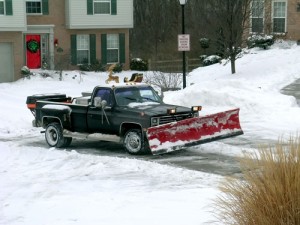 We live in snow country and chances are you work hard to make sure that your property is safe and protected during those difficult winter months. This includes making sure that you have access to the services of contractors that can do jobs such as managing the snow and ice levels on your property especially on the roof, driveway and sidewalks.
We live in snow country and chances are you work hard to make sure that your property is safe and protected during those difficult winter months. This includes making sure that you have access to the services of contractors that can do jobs such as managing the snow and ice levels on your property especially on the roof, driveway and sidewalks.
How to Choose a Snow Removal Service
You want to make sure that you can rely on your contractor to show up and do the tasks related to snow removal effectively. The contractor should have access to the necessary equipment and tools to do the job right. Additionally, the contractor should have the required business licenses and permits. Insurance is an important component of the contractor’s business credentials. Snow removal services may not be rocket science, but the tasks can potentially damage property and cause harm to occupants and to workers.
Insurance Coverage for Snow Removal Contractors
As a property owner, you maintain liability insurance to protect your assets from law suits in the event of an accident on your property. You should require the same from all contractors who work on your home or building especially those who handle machinery such as snowplows, snow blowers and salt spreaders on your property.
If your snow removal service damages a fence while doing the job, the company’s general liability insurance should repair or replace the damage. If they damage your neighbor’s parked car, your neighbor might rightly be looking to you for reimbursement of those damages. If your contractor is insured you get to stay out of it but if he is not…….then you you will be responsible for your contractors negligence and any ensuing damages. Once your insurance gets involved that may also have a negative impact on your insurance premiums.
Businesses and Homeowners are required to carry workers compensation insurance for employees AND for all those working under their direction or control. This type of insurance provides coverage for employees and those they hire should they suffer harm due to an accident while working for you or on our property. This is mandatory in all states although exceptions are made for small businesses. Without workers’ compensation however, the injured party may look to you for compensation. Even when the law allows a small contractor to waive the purchase of workers compensation for him or herself the Law does not allow you as a property owner or business owner to fail to provide workers compensation for that individual while he is working for you. ALL those working under your direction or control….like our snow removal contractors need to be properly insured. So Always request certificates of insurance from your contractors and read them carefully. Look for the box that declares “Proprietor covered” or “Proprietor NOT covered” under this policy. The Proprietor as well as all his employees ALWAYS needs to be covered while working at your property or business. Once again, claims that do find their way through to your own policy obviously will adversely affect you at renewal time. Make sure your contractors always have their own insurance coverage both General Liability and Workers Compensation.
To protect your property from harm and your assets from being attached to a lawsuit, make sure that the snow removal service you hire has the appropriate insurance coverage.
Take Steps to Prevent Damage from Ice Dams
If you live in New England, it’s likely there are ice dams on your roof from the recent snowstorms. Ice dams can be very destructive because water from melting snow can back up behind the dam and leak into your home underneath the shingles.
There are two basic approaches to dealing with ice dams:
1. Hire a professional. This is the safest way to remove snow and ice from your roof.
However, if you wish to tackle the problem yourself, follow these recommendations from roofing experts:
- Use a roof rake to remove snow buildup on the roof
- Try not to damage your shingles
- Avoid standing under icicles or roofs with large amounts of snow
- Use extreme caution when using ladders because rungs become very slippery with snow and ice on them
- Don’t use a roof rake near electrical wires
- Have someone nearby check on you in case you need assistance or are injured
2. Create channels in the ice dams.
- If you notice an ice buildup, fill a large sock with a melting agent (preferably calcium chloride) and lay it across the dam perpendicular to the gutter
- The sock will release the melting agent gradually and create a channel in the ice for water to empty through
- You may need several socks for an ice dam that runs the length of your roof
Does my house have ice dams?
Look for these warning signs:
- Large icicles hanging from gutters
- Water dripping from the roof overhang
- Leaks, stains or damaged ceilings or walls inside your home
What if water is dripping inside my home?
If you notice leaks in your home, it’s important to do what you can to mitigate the damage:
- Collect the dripping water in buckets and pans
- Mop up standing water
- Move furniture, clothes and valuables out of harm’s way
- Call a professional to deal with the snow on the roof and to dry out your house
Please remember to use extreme caution and consult a professional before attempting any dangerous home repairs yourself. Feel free to share this information with friends and family if you have found it valuable.
We care about protecting you, your family and your property and we’re glad to serve you.
How to protect your above ground pool from collapse due to the weight of ice and snow (which is not covered under the Homeowners Policy).
Particularly snowy winters can wreak havoc on above ground pools, which are designed to withstand the weight of water in the summer but are more vulnerable to the pressure of heavy snow and ice in the winter. Also, melting snow in the spring can turn to ice and expand, potentially damaging the pool, especially the cover.
It’s therefore essential to keep a close eye on your above ground pool and regularly clear the snow off its cover so it’s never entirely buried under the snow.
IS YOUR POOL BURIED?
It’s important to clear off your pool before it collapses under the weight of snow. The following tips will spare your pool a lot of punishment and allow it to make it to spring in one piece!
- Stay outside the pool when removing snow. If you try to work from inside the pool, the snow or ice could give way under your weight. This may damage the pool cover—and result in you being injured.
- Careful with the pool rim. Use a plastic shovel so as not to scratch the edges of the pool. Also avoid walking on the coping to clear snow from the rim of the pool as this could weaken or crush the pool structure.
- Don’t forget the skimmer drain. You should remove snow from inside and on top of the drain to keep it from cracking.
- Hire a professional, if you need to. By calling on a pool professional, you’ll be sure the work is done right and safely—both for your sake and your pool!
How to prevent frozen pipes and how to thaw them.
Pipes that freeze most frequently are those that are exposed to severe cold, like those in unheated interior areas like basements and crawl spaces, attics, garages or kitchen cabinets. 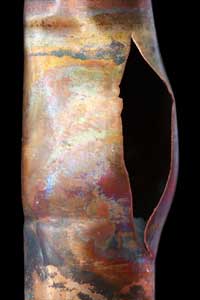 With bitterly cold arctic air and wind chills remaining below freezing, parts of the country are seeing some of its coldest weather in about 20 years, according to the National Weather Service. In these single digit temperatures, one concern for homeowners is frozen water pipes in unheated basements and crawl spaces of local homes. The American Red Cross suggests tips on how to prevent freezing and what to do if pipes do freeze. Why Pipe Freezing is a Problem Water has a unique property in that it expands as it freezes. This expansion puts tremendous pressure on whatever is containing it, including metal or plastic pipes. No matter the “strength” of a container, expanding water can cause pipes to break. Pipes that freeze most frequently are those that are exposed to severe cold, like outdoor hose bibs, swimming pool supply lines, water sprinkler lines, and water supply pipes in unheated interior areas like basements and crawl spaces, attics, garages, or kitchen cabinets. Pipes that run against exterior walls that have little or no insulation are also subject to freezing. Preventing Frozen Pipes Before the onset of cold weather, prevent freezing of these water supply lines and pipes by following these recommendations:
With bitterly cold arctic air and wind chills remaining below freezing, parts of the country are seeing some of its coldest weather in about 20 years, according to the National Weather Service. In these single digit temperatures, one concern for homeowners is frozen water pipes in unheated basements and crawl spaces of local homes. The American Red Cross suggests tips on how to prevent freezing and what to do if pipes do freeze. Why Pipe Freezing is a Problem Water has a unique property in that it expands as it freezes. This expansion puts tremendous pressure on whatever is containing it, including metal or plastic pipes. No matter the “strength” of a container, expanding water can cause pipes to break. Pipes that freeze most frequently are those that are exposed to severe cold, like outdoor hose bibs, swimming pool supply lines, water sprinkler lines, and water supply pipes in unheated interior areas like basements and crawl spaces, attics, garages, or kitchen cabinets. Pipes that run against exterior walls that have little or no insulation are also subject to freezing. Preventing Frozen Pipes Before the onset of cold weather, prevent freezing of these water supply lines and pipes by following these recommendations:
- Drain water from swimming pool and water sprinkler supply lines following manufacturer’s or installer’s directions. Do not put antifreeze in these lines unless directed. Antifreeze is environmentally harmful, and is dangerous to humans, pets, wildlife, and landscaping.
- Remove, drain, and store hoses used outdoors. Close inside valves supplying outdoor hose bibs. Open the outside hose bibs to allow water to drain. Keep the outside valve open so that any water remaining in the pipe can expand without causing the pipe to break.
- Check around the home for other areas where water supply lines are located in unheated areas. Look in the basement, crawl space, attic, garage, and under kitchen and bathroom cabinets. Both hot and cold water pipes in these areas should be insulated.
- Consider installing specific products made to insulate water pipes like a “pipe sleeve” or installing UL-listed “heat tape,” “heat cable,” or similar materials on exposed water pipes. Newspaper can provide some degree of insulation and protection to exposed pipes – even ¼” of newspaper can provide significant protection in areas that usually do not have frequent or prolonged temperatures below freezing.
During Cold Weather, Take Preventative Action
- Keep garage doors closed if there are water supply lines in the garage.
- Open kitchen and bathroom cabinet doors to allow warmer air to circulate around the plumbing. Be sure to move any harmful cleaners and household chemicals up out of the reach of children.
- When the weather is very cold outside, let the cold water drip from the faucet served by exposed pipes. Running water through the pipe – even at a trickle – helps prevent pipes from freezing.
- Keep the thermostat set to the same temperature both during the day and at night. By temporarily suspending the use of lower nighttime temperatures, you may incur a higher heating bill, but you can prevent a much more costly repair job if pipes freeze and burst.
- If you will be going away during cold weather, leave the heat on in your home, set to a temperature no lower than 65° F.
To Thaw Frozen Pipes
- If you turn on a faucet and only a trickle comes out, suspect a frozen pipe. Likely places for frozen pipes include against exterior walls or where your water service enters your home through the foundation.
- Keep the faucet open. As you treat the frozen pipe and the frozen area begins to melt, water will begin to flow through the frozen area. Running water through the pipe will help melt ice in the pipe. You can check for leaks in the pipe at this point. They do make an epoxy tape just for that needed temperature. This is emergency fix only.
- Apply heat to the section of pipe using an electric heating pad wrapped around the pipe, an electric hair dryer, a portable space heater (kept away from flammable materials), or by wrapping pipes with towels soaked in hot water. Do not use a blowtorch, kerosene or propane heater, charcoal stove, or other open flame device.
- Apply heat until full water pressure is restored. If you are unable to locate the frozen area, if the frozen area is not accessible, or if you can not thaw the pipe, call a licensed plumber.
- Also, adding a room temp device into a crawl space or known cold spot can alert you to a possible situation before they become critical. When connected to an alarm system, it can be monitored ahead of time and can prevent a broken pipe to begin with, and saving you time and money.
Check all other faucets in your home to find out if you have additional frozen pipes. If one pipe freezes, others may freeze, too.
It is never too early to winterize your home.
With Old Man Winter quickly approaching, now would be a great 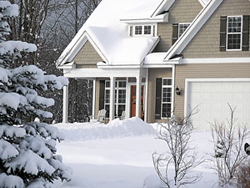 time to get prepared,by taking certain steps and you can lessen the chances of a loss to your home due to inclement weather:
time to get prepared,by taking certain steps and you can lessen the chances of a loss to your home due to inclement weather:
- Verify that your furnace is in proper working order by contacting a heating specialist for an inspection. Heating device malfunctions, including those involving space heaters, are the second leading cause of fire deaths in the U.S. Also, most experts recommend vacuuming your heating ducts every five years.
- Check your plumbing system closely since burst water pipes can spew hundreds of gallons of water into your home. Use heat tape on any pipes exposed to extremely cold weather. Learn how to shut your water off to minimize damage from burst pipes.
- Replace any cracked or missing roof shingles and verify that flashing around the vent pipes or chimney is watertight. Roof too steep? Have a reputable contractor do the repairs for you. The cost to do so certainly would be less than the deductible under your homeowners policy should a loss occur.
How to avoid damage from an ice dam on your roof
Here’s how ice-damming becomes a problem
- Home heat rises and warms the roof underside, melting exterior snow and ice.
- Water running down the roof refreezes at the cold roof edge, building ridges to form an ice dam.
- Water can’t drain and accumulates, backing up and seeping below shingles, causing ceiling, insulation, and wall damage.
- Roof loading is further increased and can lead to collapse.
Here’s the solution
- Have your roof and gutter systems inspected regularly for tightness and drainage.
- Remove any debris or obstructing tree branches.
- Consider having additional insulation installed above ceilings or having roof vents upgraded to prevent warm air from rising to the roof.
- If problems persist, have roof heating cables installed.
Winter weather losses that might have been prevented
- At owner’s secondary home, he sets heat at 50 F, but because plumbing is located behind poorly insulated external wall, pipes burst due to extreme cold.
- Ice damming: Owner fails to clear debris from gutters, and melting snow backs up, freezes, then pushes water under shingles into home, causing severe water damage.
- Radiator pipes along non-insulated wall freeze and burst due to extreme cold and wind chill, causing basement to flood.
Source: Harleysville Risk Services
Snow accumulation on roofs and the dangers it presents.
This message is a reminder from the Department of Public Safety and the Department of Fire Services.
The February 8th winter storm that hit Massachusetts presents a variety of challenges. As we approach the new week, it is anticipated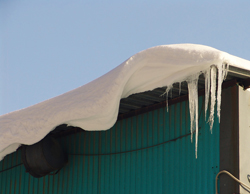 that warm temperatures and rainfall may blanket portions of Massachusetts . With the recent heavy snowfall, rain will increase the weight of snow on roofs throughout the Commonwealth. Fire and building services need to plan for the onset of storm related issues.
that warm temperatures and rainfall may blanket portions of Massachusetts . With the recent heavy snowfall, rain will increase the weight of snow on roofs throughout the Commonwealth. Fire and building services need to plan for the onset of storm related issues.
Flat roofs, lower roofs that meet higher roofs, and areas with parapets or areas of drifting snow are major concerns. Many commercial building owners may hire or bring staff on to clear snow from flat roofs to help ease the burden of additional weight. In doing so, they will also make it easier for fire services to access and traverse these areas in the event of an emergency. In areas of significant snowfall consideration should be given to the additional weight firefighters may contribute on these roofs.
Homeowners, tenants, and businesses should be cognizant of the dangers posed by heavy snow loads on roofs, and the warning signs of potential structural weaknesses. In most instances, risks posed by accumulated snow on roofs may be mitigated by safely removing the snow. from roofs of both commercial buildings and homes. As temperatures are expected to rise and fall over the next several days, every effort should be undertaken now to safely remove snow from roofs.
Removing snow from rooftops will minimize the likelihood of structural collapse. Flat and low pitched roofs, most often found on industrial buildings, but are also used in certain home designs, are at the greatest risk of buckling under heavy snow and ice accumulations. Lower roofs, where snow drifts or accumulates from higher roofs are also vulnerable.
Did you know that a cubic foot of dry snow weighs about seven pounds? While a cubic foot of wet snow may weigh up to 20 pounds. So, if at all possible, consider hiring someone to help with all of the snow clearing.
Here are some helful tips for a Homeowner in the removal of snow and ice from roofs and other areas.
Wear protective headgear and goggles when performing any of these tasks.
Use a snow rake for pitched roofs (available at most hardware stores) to remove snow from your roof.
Start from the edge and work your way into the roof.
Keep gutters, and drains clean, free of ice and snow and keep downspouts clean at ground level.
Try to shave the snow down to a 2 or 3 inches on the roof instead of scraping the roof clean, which will risk damage to your shingles or other roof covering.
Shovel snow from flat roofs throwing the snow over the side away from the building. Most plastic shovels are better, except for the ones with curved blades-those too will do some damage to your roof.
Remove large icicles carefully if they’re hanging over doorways and walkways. Consider knocking down icicles through windows using a broom stick.
Consider hiring professionals to do the job. The combination of heights plus ice makes this one of the more dangerous house chores.
If you don’t hire professionals, at least have someone outside with you in case anything does go wrong.
Keep in mind that any metal tool could conduct electricity if it touches a power line and metal tools may cause damage to the roof.
Here is list of things that homeowners SHOULD NOT do.
Don’t use open-flame devices to remove snow and ice.
Unless approved by a registered professional engineer, don’t add your weight or the weight of equipment to the roof.
Don’t use electric heating devices like hair dryers or heat guns to remove snow and ice.
Don’t use a ladder since ice tends to build up on both the rungs of the ladder and the soles of your boots.
There are several ways to recognize problems with the roof.
Sagging roof
Creaking, cracking or popping sounds
Cracked or split wood members
Bends or ripples in supports
Sheared off screws from steel frames
Sprinkler heads that have dropped down below ceiling tiles
Severe roof leak
Doors or windows that are difficult to open
Bowed utility pipes or conduit attached at ceiling
Cracks in walls or masonry
Here are some other safety tips for homeowners.
Clear snow away from downspouts so water has a place to go.
Never use cooking equipment intended for outside use indoors as a heat source or cooking device.
Do not be tempted to use a heat gun or open flame torch to melt the ice; the risk of starting a fire is huge.
If you feel you are in immediate danger, get outside and call 9-1-1.
Never use your oven for heat.
Space heaters need space, so use them in a 3-foot circle of safety; free of anything that catch fire. Space heaters are not designed to replace your central heating system; they are only designed to provide a little extra heat on a temporary basis. So be sure to turn them off when you leave room or go to bed at night.
Clear snow away from furnace and dryer exhaust vents to prevent carbon monoxide poisoning.
Make sure you smoke alarms and carbon monoxide detectors are working.
Check your outside fuel (furnace) and dryer exhaust vents, making sure that they are not obstructed by snow or ice.
Here are some other safety tips for Business owners.
If you are going to use a snowblower, make sure that it has been approved by a structural engineer to be used on a roof, and that the blower is set to a high level above the roof so as not to damage roof membrane.
Keep gutters, downspouts and drains clean.
Shovel snow from flat roofs throwing the snow over the side away from the building.
Try to shave the snow down to a 2 or 3 inches on the roof instead of scraping the roof clean, which will risk damage to your shingles or other roof covering.
Keep in mind that any metal tool could conduct electricity if it touches a power line.
Use a snow rake for pitched roofs ( available at most hardware stores) to remove snow from your roof.
Remove large icicles carefully if they’re hanging over doorways and walkways.
Always wear protective headgear and goggles when performing any of these tasks.
Most plastic shovels are better, except for the ones with curved blades-those too will do some damage to your roof.
Start from the edge and work your way into the roof.
There are several ways to recognize problems with the roof on Commercial Buildings.
Sagging roof steel – visually deformed
Cracks in welds of steel construction
Water puddles where it never has before
Bowed utility pipes or conduit attached at ceiling
Creaking, cracking or popping sounds
Bends or ripples in metal supports
Severe roof leaks
Sheared off screws from steel frames
Doors that pop open
Doors or windows that are difficult to open
Cracks in walls or masonry
Cracked or split wood members
Sprinkler heads pushed down below ceiling tiles
What to do if you have these problems.
Call your local building or fire department.
If there is imminent danger, evacuate the building and call 911.
What other assistance is available?
Many fire departments have regional technical rescue teams available to local departments in case of collapse.
Massachusetts Task Force 1 is an Urban Search and Rescue Team in Beverly . The team is comprised of Police, Fire, EMS and Civilians who respond to major disasters under a contract with the Federal Emergency Management Agency (FEMA). Currently there are 150 people on the MATF-1 team.
How to remove ice dams from roof safely.
Winter presents homeowners with many unique challenges as the weather changes. Among the winter-fueled obstacles that come each year, ice dams can be one of the most serious. Ice dams that build along the edges of the roof can add to the amount of snow and precipitation that will accumulate. A snow-packed roof is bad news. Preventing the accumulation of ice on the roof edge should be a regular part of every homeowner’s annual winter preparation.
Ice dams form because of the roof’s uneven temperature. The roof becomes heated directly above the interior spaces of the house. 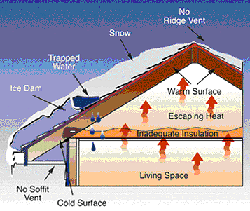 However, this heat does not reach the edges and the overhang. As a result, melted snow and rain will flow to these areas where it will freeze once again. Allowing your roof to maintain an even temperature starts with insulation. Your goal is to stop warm air in the house from flowing into the attic. To do this, seal all the gaps in addition to ensuring that all of the insulation is in good shape. The ideal temperature for the roof deck itself is 30 Fahrenheit. When the entire roof maintains a consistent temperature, the snow eventually clears evenly and naturally. It is also critical to have good ventilation between the roof deck and the insulation. Poor ventilation leads to the accumulation of moisture in this area. Excess moisture compounds your problems by encouraging lamination deterioration and mold growth.
However, this heat does not reach the edges and the overhang. As a result, melted snow and rain will flow to these areas where it will freeze once again. Allowing your roof to maintain an even temperature starts with insulation. Your goal is to stop warm air in the house from flowing into the attic. To do this, seal all the gaps in addition to ensuring that all of the insulation is in good shape. The ideal temperature for the roof deck itself is 30 Fahrenheit. When the entire roof maintains a consistent temperature, the snow eventually clears evenly and naturally. It is also critical to have good ventilation between the roof deck and the insulation. Poor ventilation leads to the accumulation of moisture in this area. Excess moisture compounds your problems by encouraging lamination deterioration and mold growth.
Soffit vents are also a valuable tool for fighting ice dams. These kinds of vents allow cold air to circulate beneath the entirety of the roof. Additional material that ensures seals may be needed during the winter as well. Adding extra insulation in extreme conditions never can hurt. Ice damming could also be related to the deterioration of the flashing around chimneys and other roof gaps. Sealing and insulating ducts and duct pipes that flow through the roof and attic also keeps heat from leaking towards the underside of your roof. Fiber-reinforced mastic on the joints of HVAC ducts can do wonders for heat retention.
In the event that you are experiencing ice dams during the winter, there are a few symptoms that indicate that you may have a problem. Ice dams on the roof will cause specific areas of the roof to transmit cold temperatures. Despite insulation, the area where the ice dam has formed will transmit its lower temperatures through to the trusses that connect with your ceiling. As this cold spot comes in contact with the home’s warm air, condensation occurs. The moisture traps dust and eventually forms mildew that will appear darker than the rest of the ceiling. When this occurs, begin by bleaching the mildewed surface. In some cases, this cleaning will be enough to remedy the problem. However, excessive staining can require a stain-blocking primer and a layer of paint. Should the trusses become cold enough to actually shift as they contract, you are likely to see cracks appear along the joint of the ceiling and the wall. These cracks can be caulked temporarily. The best long-term solution is to cover the joints with molding. Attach the molding only to the ceiling so that it is free to move with the structure as the temperatures fluctuate.
Tips to help with ice dams
Making a homemade Ice melt socks by using old panty hose can create melt channels in the ice dam. These channels will allow melted 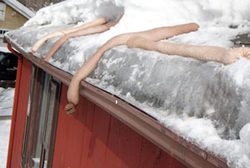 water from your roof to drain off your roof, reducing the ice dam effect. This method may look & sound funny, but it is one of the safest way to create a melting path without heating cables or chipping away at ice dams. Make sure you use ice melter that is safe for your roof, check with your local hardware expert on this prior to using.
water from your roof to drain off your roof, reducing the ice dam effect. This method may look & sound funny, but it is one of the safest way to create a melting path without heating cables or chipping away at ice dams. Make sure you use ice melter that is safe for your roof, check with your local hardware expert on this prior to using.
Always take caution when attempting to remove any ice damn, consult with a professional first. Your safety comes first.
Winter can be enjoyed when you are properly prepared!
Now is the time to start your preparations for winter 2012-2013 and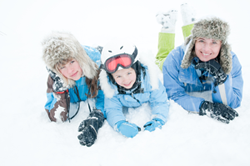 the storms that will undoubtedly be coming our way. As extreme weather events in New England continue, we can no longer get by with our old assumptions that all we need is a few flashlights to get by. The storms are getting bigger and more frequent and that means more damage throughout the area and more days potentially without heat or electricity. Now is the time to create your own “survival” plan and to gather what you may need.
the storms that will undoubtedly be coming our way. As extreme weather events in New England continue, we can no longer get by with our old assumptions that all we need is a few flashlights to get by. The storms are getting bigger and more frequent and that means more damage throughout the area and more days potentially without heat or electricity. Now is the time to create your own “survival” plan and to gather what you may need.
Sometimes, winter storm warnings are given well in advance so that we have time to prepare or change our schedules. One idea is to organize your commuting plans in advance so you are able to carpoolwith someone who has four-wheel drive. Storm advisories often can turn into warnings. Just because you may be in an advisory zone may not mean you are off the hook. You could find yourself in an outer band of rain/ice mix, which is just as dangerous as a snowstorm.
A Northeaster, more commonly referred to as a Noreaster, is exclusive to New England winters. These types of storms start in the Atlantic in the fall or winter months. Think of this storm as a snow-filled hurricane, with high winds and blizzard conditions dumping snow measured in feet, not inches.
Given the extremes, it makes sense to have a plan and emergency supplies before we face any weather alerts. The familiar sight of televised storm coverage with people in long lines buying supplies and stores selling out of the things we need the most does not have to happen to you. Take inventory now and start to pull together your winter home emergency kit, which should include:
- Extra batteries for flashlights, radios.
- Emergency charger for cell phone (some hand-crank powered weather radios offer this feature).
- First aid kit stocked with bandages, sanitary wipes, gauze and rubbing alcohol.
- Battery-powered lanterns for ample light in each room (in a pinch, you can raid your Christmas decorations for battery-powered LED lights).
- Warm blankets to add to bedding when you have no heat.
- Emergency supply of prescription medication that you may need.
- Over-the-counter medications that you may need, such as analgesics.
It is a good rule of thumb that each person will require a gallon of water per day in reserve if we lose access to our water supply. Think of food that does not need to be cooked. Canned beans and vegetables, boxed cereals and energy bars are good choices.
Make sure you have a handle on exterior issues too. Your shovel or snow blower needs to be in good working order and in an accessible location. If you have a generator, test it in the fall to make sure it is in good working order and that the you have sufficient fuel. Clean your gutters now and again after a snowstorm and remember to check for ice dam formations along your roofline. Clearing gutters helps ensure that melting snow can flow freely without collecting on the roof and causing a potential leak or worse, a collapse. Many area hardware stores sell roof rakes. If you are not able to clear your roof or gutters on your own, arrange ahead of time for someone to do this for you.
Preparations can help ease the stress of demanding winter conditions too. So anticipate what you might need, and pack plenty of patience along with those extra supplies because when it comes to winter in New England we can always expect some of the unexpected.
Insurance and Your Snow Plow in Massachusetts
Top 5 Questions about Snow Plows
From Commerce Insurance Company
As the winter weather approaches, we would like to share some of the most common questions asked by our commercial customers who plow or remove snow as part of their business.
Question: I have a plow on my light truck and plan to clear snow. Do I need a Business Auto liability policy?
Answer: Not necessarily. A snow plow or other detachable equipment does not disqualify a risk from a Personal Auto Policy even if the insured is paid for services. If your customer is an individual, a personal policy with class 30 may be appropriate.
Question: I plow for the town and businesses that require additional insured status. Do I need a Business Auto liability policy?
Answer: Yes. Regardless of the weight or ownership of the vehicle, an additional insured cannot be added to a Personal Auto Policy. A Business Auto policy should be used. The Enhancer endorsement automatically added to your voluntary policies for no additional fee includes additional insured status when required by written contract. The MM9950 can be added to include additional insured status to voluntary policies where no written contract exists or for ceded policies with or without a written contract.
Question: Will the premium increase on my Business Auto Policy if I offer plowing services for a fee?
Answer: Probably not. Assuming that plowing is a side operation, and given the trend towards milder winters in Massachusetts, it is hard to imagine that a vehicle will plow more than 20% of the time. Nevertheless, if plowing exceeds 20%, then a “service” classed vehicle might have to be changed to a “commercial” class (80/20 rule).
Question: I am attaching a plow to my vehicle. Does my Business Auto Policy provide physical damage coverage for the plow?
Answer: Yes. There is physical damage coverage for the plow (equipment) as long as the vehicle to which it is attached also carries physical damage coverage. The cost new of the vehicle should be increased to include the cost new of the plow.
Question: I have a Business Auto Policy now. Does my policy provide coverage if someone slips on ice and is injured after I have finished plowing?
Answer: No. Incidents that occur after you have completed your job are not covered on an unendorsed policy. Those incidents, in insurance terms, are called “completed operations liability” and if you are being asked to cover them you will need to purchase the endorsement. Completed operations are covered on a General Liability policy, not a business auto policy. In order to keep liability rates low , most insurance company underwriters will provide this coverage when plowing is limited to driveways, streets and roads. Because of pedestrian traffic in parking lots many company’s will not provide coverage if you plow parking lots. We have markets for all the different snow plow risks but, as you can see, it is important to be as specific as possible about the kind of plowing that you do.

